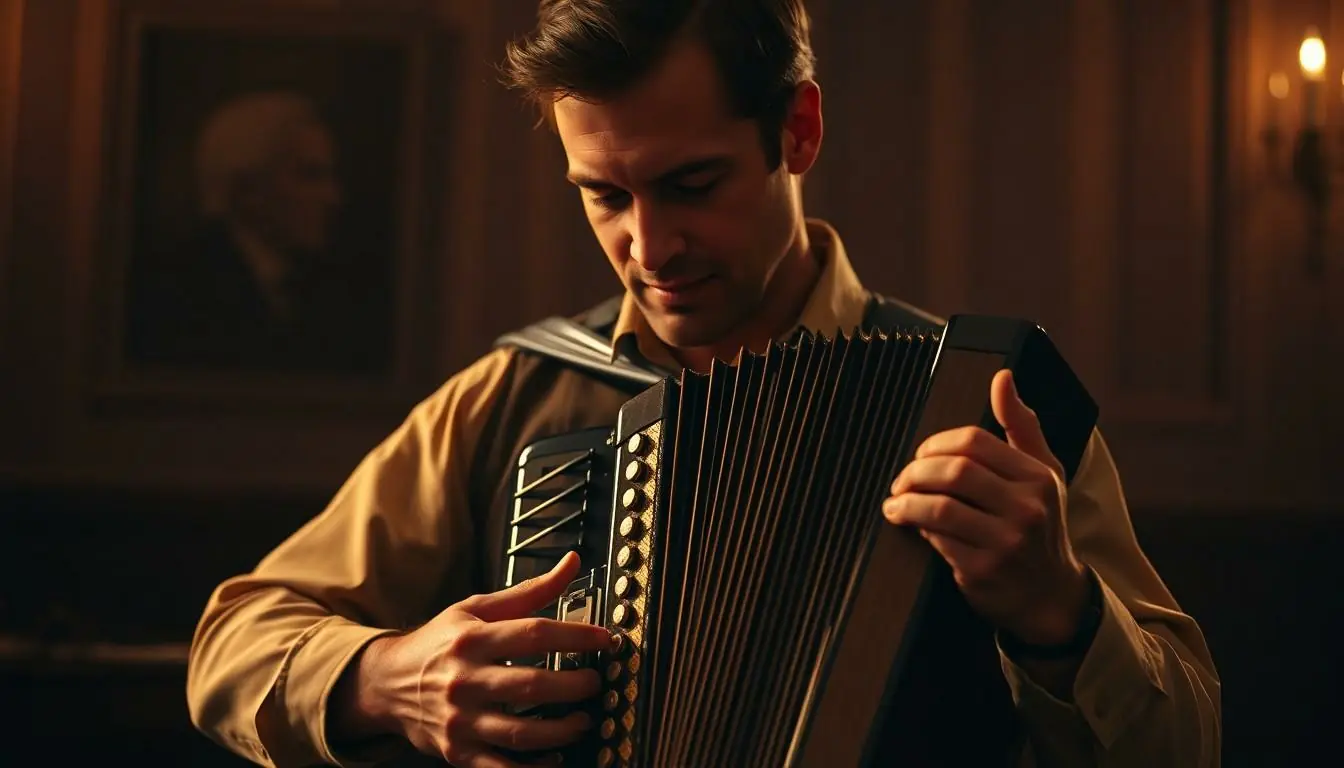Astor Piazzolla’s “Oblivion” isn’t just a piece of music; it’s a journey into the heart of tango, wrapped in a blanket of nostalgia. Imagine sipping a fine wine while the haunting melodies pull at your heartstrings, making you feel like you’re dancing in a dimly lit Buenos Aires café. This composition has a magical way of transporting listeners, making them ponder life’s fleeting moments and lost loves.
But don’t let the elegance fool you—there’s a playful side to “Oblivion” that sneaks up on you like an unexpected tango partner. Piazzolla masterfully blends traditional tango with jazz influences, creating a sound that’s both timeless and refreshingly modern. So, whether you’re a seasoned music aficionado or just someone looking to spice up their playlist, “Oblivion” promises an experience that’s as captivating as it is unforgettable.
Table of Contents
ToggleOverview of Oblivion by Astor Piazzolla
Astor Piazzolla’s “Oblivion” stands as a hallmark of contemporary tango. This piece features a blend of lush harmonies and poignant melodies that resonate with deep emotional intensity. Melodic lines evoke images of nostalgia, inviting listeners to reflect on life’s transient nature. The composition showcases Piazzolla’s innovative approach, integrating jazz elements that enhance the traditional tango framework.
Created in 1982, “Oblivion” quickly gained acclaim, becoming one of Piazzolla’s most celebrated works. Its arrangement allows for various interpretations, ranging from solo performances to orchestral renditions. Each version maintains the original’s essence while adding unique flavors through different instrumentation.
Piazzolla wrote the piece for the film “Enrico IV,” contributing to its cinematic quality. The use of minor keys emphasizes the underlying melancholy, drawing listeners into an introspective journey. This emotional depth resonates deeply with audiences, creating a universal connection to themes of love and loss.
Musicians frequently perform “Oblivion” in diverse settings, from intimate concert halls to grand stages. The piece’s flexibility ensures it captivates both seasoned musicians and casual listeners. Many view it as a gateway to understanding Piazzolla’s larger repertoire, reflecting the evolution of tango music.
With its haunting beauty, “Oblivion” encourages people to experience the artistry of tango. The piece’s timeless appeal continues to inspire new generations of musicians, deepening appreciation for Piazzolla’s contributions.
Musical Structure and Composition
“Oblivion” embodies a rich musical structure that showcases Piazzolla’s innovative approach to tango. Its engaging composition includes various intricate elements that contribute to its emotional resonance.
Melodic Elements
Melody plays a crucial role in “Oblivion,” characterized by sweeping lines and gentle contours. The main theme presents a captivating, lyrical quality that evokes deep feelings. Melody often alternates between longing and hope, emphasizing the themes of love and loss. Each phrase unfolds delicately, creating a sense of introspection. Subtle nuances and variations enhance its expressiveness, inviting interpretations from various musicians. Performers use these melodic elements to connect personally with audiences, allowing for varied emotional experiences in each rendition.
Harmonic Progression
Harmonic progression in “Oblivion” adds depth and complexity to its structure. The composition predominantly features minor keys that underscore its somber mood. Chord choices reflect both tension and resolution, enhancing the overall emotional context. Transitioning from dissonance to consonance, harmomic shifts create anticipation and release. Each chord progression leads seamlessly into the next, maintaining a fluid, cohesive experience. Such harmonic frameworks provide a foundation for improvisation, encouraging musicians to explore new possibilities within a traditional tango context.
Historical Context
“Oblivion” embodies pivotal moments in tango evolution, intertwining traditional and modern elements. This composition reveals the rich tapestry of tango music’s influence on global sound.
Influence of Tango Music
Tango music’s roots trace back to the late 19th century, originating in Buenos Aires. It merged African rhythms, European melodies, and local folk styles, creating a unique sonic landscape. As a result, Piazzolla’s compositions redefine tango, integrating jazz harmonies and classical structures. Musicians often embrace the emotional depth of tango, allowing “Oblivion” to resonate with diverse audiences. This piece stands as an example of tango’s adaptation and enduring appeal, striking a chord with listeners across generations.
Piazzolla’s Artistic Evolution
Astor Piazzolla revolutionized the tango genre, moving beyond conventional boundaries. Early influences included traditional tango masters, but he later immersed himself in jazz and classical music. These experiences shaped his distinctive style, evident in “Oblivion.” Creative exploration led to a fusion of genres, resulting in intricate arrangements and unconventional rhythms. As a prominent figure, Piazzolla’s innovative approach not only redefined tango but also expanded its global reach. His work inspires countless musicians, showcasing the versatile nature of this iconic genre.
Interpretations and Performances
Astor Piazzolla’s “Oblivion” inspires a wealth of interpretations and performances, showcasing its versatility and emotional depth. Musicians globally have embraced the piece, capturing its essence through various styles.
Notable Recordings
Renowned cellist Yo-Yo Ma’s recording of “Oblivion” gained widespread acclaim, emphasizing the composition’s lyricism and emotional resonance. Similarly, the ensemble Quarteto Gelato brings a fresh approach, blending classical strings with Latin influences. Additionally, singer Susana Baca’s rendition infuses a vocal narrative, highlighting the piece’s storytelling potential. Each artist’s interpretation offers a unique lens into Piazzolla’s work, ensuring “Oblivion” remains vibrant across diverse musical landscapes.
Analysis of Different Arrangements
Arrangements of “Oblivion” vary significantly, adapting to solo instruments and full orchestras. Solo guitar versions often accentuate the piece’s intimacy, inviting personal expression. String quartets emphasize harmony and interplay, creating lush textures that deepen emotional impact. In contrast, orchestral adaptations amplify the original’s grandeur, showcasing intricate counterpoints. Each arrangement uncovers new layers, ensuring the piece resonates with different audiences while honoring its tango roots.
Cultural Impact and Legacy
“Oblivion” significantly shaped the perception of tango music on a global scale. Piazzolla’s innovative blending of traditional elements with jazz influences allowed for a renewal of interest in tango. Artists and ensembles worldwide cover “Oblivion,” establishing it as a go-to piece in various settings. Recordings by Yo-Yo Ma and Quarteto Gelato highlight its emotional richness and adaptability.
Cultural performances often include “Oblivion” to showcase the emotional depth inherent in Argentine tango. Influencers in classical and contemporary music celebrate Piazzolla’s work, which resonates with a wide audience, bridging generational gaps. Festivals dedicated to tango sometimes feature “Oblivion,” elevating its status in the realm of world music.
Renown results from its diverse arrangements, allowing the piece to thrive in various musical formats. Soloists frequently interpret “Oblivion,” infusing personal artistry into performances, while orchestras offer grander renditions that capture its expansive character. The ability to evoke nostalgia and reflection remains paramount in its legacy.
Exploring the intersections of genres, “Oblivion” demonstrates the versatility of tango music. This composition remains a staple in music education, introducing students to the emotional range and structural complexities of tango. Each interpretation of “Oblivion” reveals layers that continue to inspire musicians, ensuring its enduring influence in contemporary culture. Such artistic expressions anchor the legacy of “Oblivion,” celebrating a piece that transcends its origins to touch hearts worldwide.
Conclusion
Astor Piazzolla’s “Oblivion” transcends traditional tango, inviting listeners into a world of emotional depth and nostalgia. Its unique blend of jazz and classical influences creates a rich tapestry of sound that resonates across generations. The piece’s adaptability ensures it finds a place in various musical settings, allowing performers to express their artistry while honoring its roots.
As a hallmark of contemporary tango, “Oblivion” continues to inspire musicians and captivate audiences. Its haunting melodies and intricate harmonies evoke reflections on love and loss, making it a timeless masterpiece. Piazzolla’s innovative spirit not only redefined the genre but also expanded its global appeal, ensuring that “Oblivion” remains a cherished part of the musical landscape.






